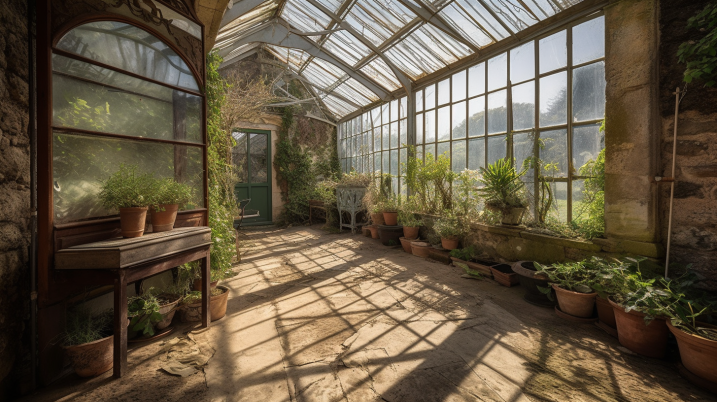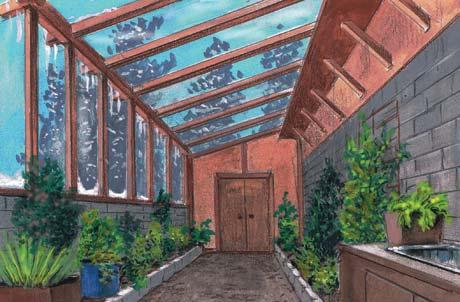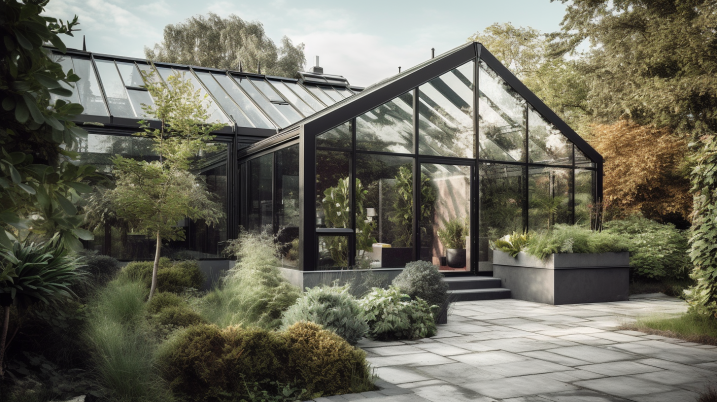
Imagine having your own little oasis right at home, where you can cultivate a colorful array of flowers, grow your own fruits and vegetables, and enjoy the tranquility of nature all year round. With a greenhouse attached to your house, you can turn this dream into a reality. Not only does a greenhouse offer a charming addition to your home, but it also provides a controlled environment for optimal plant growth. In this article, we will guide you through the process of building a greenhouse attached to your house, allowing you to bring the beauty and bounty of the outdoors indoors.
Choosing the Right Location
Consider the Orientation
When choosing the location for your greenhouse, it’s important to consider its orientation in relation to the sun. You’ll want to maximize the amount of sunlight that your plants receive throughout the day. Look for a spot that gets plenty of southern exposure to ensure optimal sunlight exposure.
Ensure Ample Sunlight
In addition to considering the orientation, you should also assess the amount of direct sunlight that the location receives. Ideally, the chosen area should be free from shading caused by nearby trees, buildings, or other obstructions. Remember, plants need sunlight to thrive, so it’s crucial to provide them with ample natural light.
Avoid Obstructions
To further ensure your greenhouse receives sufficient sunlight, it’s important to avoid any potential obstructions. Nearby structures or tall objects can cast shadows over your greenhouse, potentially reducing sunlight exposure throughout the day. Choose a location that is free from such obstructions to promote healthy plant growth.
Determining the Size and Type of Greenhouse
Assess Your Needs
Before you start building your greenhouse, it’s important to assess your needs and consider what you’ll be using it for. Are you planning to grow flowers, vegetables, or both? Determine the amount of space required for your desired plants as well as any additional features like workbenches or storage areas.
Consider Available Space
Next, consider the available space on your property for the greenhouse. Measure the area to determine the maximum size you can accommodate. It’s also important to consider the layout of your property and how the greenhouse will fit into the existing landscape. Ensure that there is enough room for proper ventilation and easy access.
Select the Type of Greenhouse
Once you’ve assessed your needs and available space, it’s time to choose the type of greenhouse that best suits your requirements. There are various types available, such as lean-to greenhouses, attached greenhouses, and freestanding structures. Consider factors like your budget, available space, and desired aesthetic when making the decision.

Building Permits and Regulations
Check Local Building Codes
Before you start construction, it’s essential to check your local building codes and regulations regarding the construction of greenhouses. Different areas may have specific rules and requirements that you need to adhere to. Familiarize yourself with these regulations to ensure that you obtain all the necessary permits and follow the appropriate guidelines.
Determine Necessary Permits
Once you understand the local building codes, determine the necessary permits you’ll need for your greenhouse construction. This may include permits for building, electrical work, plumbing, or any other relevant permissions. Research the specific requirements in your area and prepare the required documentation to obtain the permits before you begin building.
Consult with Professionals
If you’re unsure about any aspect of the permits and regulations, it’s always a good idea to consult with professionals. Engage with local contractors, architects, or greenhouse specialists who can guide you through the process and ensure that you comply with all the necessary regulations. Their expertise can save you time, money, and potential headaches down the line.
Preparing the Foundation
Clearing the Site
Once you have obtained the necessary permits and prepared your plans, it’s time to start preparing the site for your greenhouse. Start by clearing the area of any vegetation, rocks, or debris. This will ensure a clean and level surface for building the foundation.
Leveling the Ground
After clearing the site, it’s essential to level the ground to provide a stable base for your greenhouse. Use a shovel or a grading tool to remove any excess dirt or high spots. Leveling the ground will help prevent issues such as water pooling or structural instability once the greenhouse is in place.
Building a Strong Base
To create a strong and durable foundation for your greenhouse, consider options such as concrete slabs, treated lumber, or gravel. The type of base you choose will depend on factors like your budget, climate, and personal preference. Ensure that the foundation is level, solid, and capable of supporting the weight of the greenhouse structure.

Design and Construction Materials
Selecting the Greenhouse Design
Choosing the right design for your greenhouse is key to its functionality and aesthetic appeal. Consider factors such as your climate, budget, and personal taste when selecting the design. Options include traditional glass structures, polycarbonate panels, or even repurposed materials for a more eco-friendly approach.
Choosing Construction Materials
When deciding on the construction materials for your greenhouse, consider durability, cost, and energy efficiency. Common choices include aluminum, wood, or steel for the framework, while the glazing material can be glass, polycarbonate, or acrylic. Research the pros and cons of each material to make an informed decision based on your specific needs.
Considering Energy Efficiency
To maximize the energy efficiency of your greenhouse and minimize your environmental impact, consider incorporating energy-saving features. This may include insulation, double-glazed windows, or shade cloth to regulate temperature and reduce energy consumption. By designing for energy efficiency, you can create an environmentally friendly space that helps your plants thrive.
Structural Considerations
Framing the Structure
Constructing the frame of your greenhouse is a crucial step in the building process. Whether you choose to use wood, aluminum, or steel, ensure that the frame is sturdy and able to withstand the elements. Take into account the load-bearing capacity of the frame to support the weight of the glazing material and any additional features like shelving or hanging baskets.
Installing the Roof
The roof of your greenhouse is instrumental in providing the right amount of sunlight and protecting your plants from the elements. Consider options such as sloping roofs to allow for proper water drainage or flat roofs for a sleek, modern design. Install the roof according to your chosen design, taking care to seal any potential areas of water infiltration.
Constructing the Walls
When constructing the walls of your greenhouse, consider factors such as insulation, ventilation, and aesthetics. Decide on the number of walls and their respective materials based on your specific needs. Remember to include features such as doors and windows for easy access and efficient airflow within the greenhouse.

Installing Glazing and Ventilation
Choosing the Right Glazing Material
The choice of glazing material for your greenhouse will impact its energy efficiency, durability, and performance. Glass offers excellent clarity and longevity but may be more expensive. Polycarbonate panels provide insulation and durability but may yellow over time. Consider factors like cost, thermal insulation, and UV transmittance when selecting the glazing material.
Installing Windows or Panels
Proper ventilation is crucial for maintaining a healthy growing environment in your greenhouse. Install windows or panels at strategic locations to allow fresh air circulation and regulate temperature and humidity levels. Consider features like adjustable vents or automated systems that can help control airflow based on specific plant requirements or weather conditions.
Implementing Ventilation Systems
In addition to windows or panels, consider implementing additional ventilation systems to ensure optimal airflow within your greenhouse. Options include exhaust fans, evaporative cooling systems, or mechanical ventilation systems. Evaluate your specific needs and climatic conditions to determine the ventilation system that will work best for your greenhouse.
Electrical and Plumbing
Installing Electrical Outlets
To provide power for lighting, heating, or any other electrical requirements, install outlets strategically throughout your greenhouse. Plan the placement of outlets based on your specific needs, taking care to ensure they are properly grounded and safely installed. Consider consulting an electrician to ensure compliance with electrical codes and standards.
Adding Heating and Cooling Systems
Depending on your climate and the types of plants you intend to grow, you may need to incorporate heating and cooling systems in your greenhouse. Options include electric heaters, radiant heating systems, or evaporative coolers. Choose a system that suits your specific requirements to help maintain optimal growing conditions for your plants.
Incorporating Plumbing
If you plan on using a water source within your greenhouse, such as for automated irrigation or misting systems, you’ll need to incorporate plumbing into your design. Consult with a plumber to determine the best location for water lines and fixtures. Properly plan and install plumbing systems to ensure efficient water distribution to your plants.

Interior Setup and Irrigation
Arranging the Interior Layout
Consider the layout and organization within your greenhouse to make the most of the available space. Arrange your plants in a way that optimizes sunlight exposure and allows for easy access and maintenance. Plan for additional features like workbenches, shelving units, or storage areas to efficiently utilize the interior space.
Installing Shelves and Benches
Shelves and benches are essential for creating additional space for your plants and providing a comfortable working area. Install sturdy and properly anchored shelves or benches to support the weight of your plants and gardening supplies. Consider options such as adjustable shelves or rolling benches for versatility and flexibility within your greenhouse.
Setting up an Irrigation System
An efficient and reliable irrigation system is crucial for maintaining optimal moisture levels in your greenhouse. Consider options like drip systems, misters, or automated sprinklers to ensure your plants receive the right amount of water. Plan the layout of your irrigation system and install it accordingly, taking care to monitor and adjust water distribution as needed.
Choosing the Right Plants
Consider Climate and Seasons
When choosing plants for your greenhouse, it’s important to consider your local climate and the changing seasons. Select plants that are well-suited to your region’s temperature, humidity, and daylight hours. Take into account the seasonal variations and plan accordingly, considering the need for heating or cooling measures during extreme weather conditions.
Select Suitable Plant Varieties
Based on your personal preferences and the conditions within your greenhouse, select plant varieties that will thrive in that environment. Consider factors such as sunlight requirements, temperature range, and space limitations. Choose plants that are compatible with each other in terms of growth habit, size, and water needs to create a harmonious and productive greenhouse.
Plan for Rotation and Succession
To maximize your greenhouse’s productivity, plan for plant rotation and succession planting. This involves planting different crops at different times to ensure a continuous harvest and prevent nutrient depletion. Keep track of planting dates, growth periods, and harvest times to ensure a well-managed and fruitful greenhouse throughout the year.
By following these comprehensive guidelines, you’ll be well on your way to building a greenhouse attached to your house. Remember to consider factors such as location, size, permits, design, and plant selection to create a thriving and sustainable space for your gardening pursuits. Enjoy the process and the rewards of growing your own plants in the comfort of your own home!


